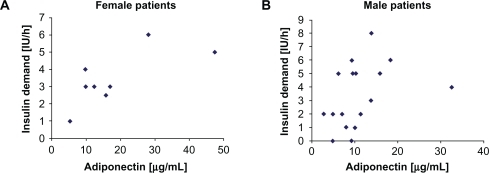Figures & data
Table 1 Gender, age, underlying reason of sepsis, side diagnosis, C-reactive protein levels, white blood count, self-reported (or estimated) body mass index, and Simplified Acute Physiology Score (SAPS II) without Glasgow Coma Scale of the 25 septic patients
Figure 1 A,B) Insulin demand after diagnosis of sepsis and serum adiponectin levels of female () and male () patients. The 2 extreme values of adiponectin (47.6 μg/mL in female patients and 32.6 μg/mL in male patients) represent the 2 patients with the lowest body mass index (22 kg/m2 and 18 kg/m2) and the lowest leptin levels (0.9 ng/mL and 0.3 ng/mL, respectively), although body mass index showed no significant negative correlation with adiponectin levels (females: r = −0.37, P = 0.18; males: r = −0.16, P = 0.27).
